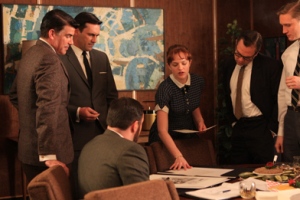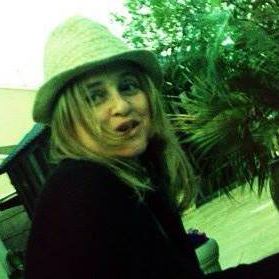 In the second episode of Season One of Mad Men, one of the copywriters is showing the agency to a new secretary, trying to impress her: “You know . . . there are women copywriters!” he claims. – “Good ones?” – “Sure,” he says. “I mean, you can always tell when a woman is writing copy. But sometimes she may be the right man for the job, you know?” Not much has changed since the days depicted in Mad Men. Or at least, not enough. This is still a man’s world – and sometimes a woman will get a writing job not because she is “the right man for the job” but because she is a woman.
In the second episode of Season One of Mad Men, one of the copywriters is showing the agency to a new secretary, trying to impress her: “You know . . . there are women copywriters!” he claims. – “Good ones?” – “Sure,” he says. “I mean, you can always tell when a woman is writing copy. But sometimes she may be the right man for the job, you know?” Not much has changed since the days depicted in Mad Men. Or at least, not enough. This is still a man’s world – and sometimes a woman will get a writing job not because she is “the right man for the job” but because she is a woman.
In the writers’ rooms I have worked in it was usually myself and a bunch of guys. So I was in charge of the female perspective – and I did not want to be that. I knew that what was expected from me was to say things like ‘a woman would never do that’ or to be in charge of the ‘emotional’ moments – when all I wanted was to be one of the guys, and to be a writer first and a woman second. So I would push myself in the opposite direction: my biggest wish was for my writing to be genderless, even better: to have a male style, to be indistinguishable from that of my male colleagues. Many years later, I realized that that was the wrong approach. Ignoring inequality and avoiding the probability of being pushed into some feminist corner if you point at it, wasn’t going to make me one of the guys. Most importantly it would never allow me to be a writer first, and a woman second.
To be honest, I did not know what would allow me to do that. Perhaps this is why this is one of the topics that kept coming up in the conversations in my book Inside the Writers’ Room, together with the fact that there are so very few African-American or Hispanic or Asian writers. American TV is written for the most part by white men.
As, indeed, American movies and European TV and movies. This hasn’t always been that way. From Frances Marion to Dorothy Parker, most Hollywood screenwriters of the 1920s and early 1930s were women. So what went wrong? And why is it that women writers are currently even actively losing ground? According to the Writer’s Guild of America’s latest study, female writers accounted for only 15 percent of feature film work in 2012, down from 17 percent in 2009 and for 27 percent of television writers, down ‘only’ 1 percent from 2009.
Women aren’t, of course, the only underrepresented group. In the WGA study it is made clear that while writers aged 41-50 were employed at the highest rates and received the most earnings in TV, there was a sharp decline beyond the age of 60. Minority writers made up only 5 percent of film writing jobs, the same number from 2009. Interestingly enough, their pay as well as female writers’ pay has declined at the same time that white male writers’ pay has gone up. (I will be here consciously concentrating on the gender issue, notwithstanding the fact that this is also a race issue and an age issue – and all the reflections below can be applied in relation to all these issues too.)
In addition there are fewer female writers at the top of the writing profession. Carol Mendelssohn, who runs CSI, Shonda Rhimes, who is running three shows at the moment, Janet Leahy, Jenny Bicks (both interviewed in Inside the Writers’ Room) or, more recently, creators Jenji Kohan and Lena Dunham are some of the exceptions. It is hard for women to move up the ranks, which is where most see the stop. Women don’t seem to get past the level of supervising producer very easily.
The situation with women directors is even worse. Despite the fact that half of film school graduates are women, women directed only 9% of the top 250 films of 2012, and in 2013, only nine percent of DGA features released in theaters were directed by women. The numbers have fluctuated slightly from year to year, but they continue to fall below 10 percent. In fact, according to Martha Lauzen (The Celluloid Ceiling, San Diego State University,) in the last 15 years it topped out at only 11% in the year 2000. The same researcher found that women comprised a mere 11% of directors working on broadcast television programs during the 2011-12 prime-time season, representing no increase from the year prior and that 90% of network TV shows employed no female directors at all in the 2011-2012 season.
Clearly, there’s a systemic problem. What does it mean for the stories we tell and for the stories we are told?
To be continued.
Next Up: Post #11: How to Change the World (And, Most Importantly, Why) – Part II (scheduled for )
If you are interested in reading more, including the full interviews on their process as writers with creators such as Terence Winter, Tom Fontana, Warren Leight, Robert Carlock, Janet Leahy and many more, you can purchase the book Inside the Writers’ Room. Conversations with American Writers here.
 Christina Kallas has written and produced several feature films and TV shows in Europe before she relocated to New York in 2011, where she is currently teaching at Columbia University’s and Barnard College’s Film Programs, and editing her next feature film (and her first as a director,) 42 Seconds of Happiness. She is the author of six books in her three writing languages, including the above book as well as Creative Screenwriting: Understanding Emotional Structure (London/New York, 2010). Most recently, she was honored for her outstanding contribution to the international writers’ community in her eight years of tenure as President of the Federation of Screenwriters in Europe. You can reach her at improv4writers@gmail.com and follow her on Facebook or Twitter and join the Writers Improv Studio group page for updates.
Christina Kallas has written and produced several feature films and TV shows in Europe before she relocated to New York in 2011, where she is currently teaching at Columbia University’s and Barnard College’s Film Programs, and editing her next feature film (and her first as a director,) 42 Seconds of Happiness. She is the author of six books in her three writing languages, including the above book as well as Creative Screenwriting: Understanding Emotional Structure (London/New York, 2010). Most recently, she was honored for her outstanding contribution to the international writers’ community in her eight years of tenure as President of the Federation of Screenwriters in Europe. You can reach her at improv4writers@gmail.com and follow her on Facebook or Twitter and join the Writers Improv Studio group page for updates.





